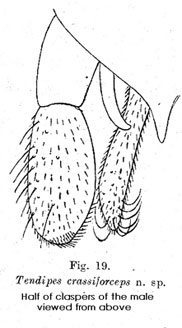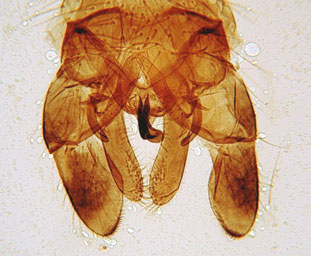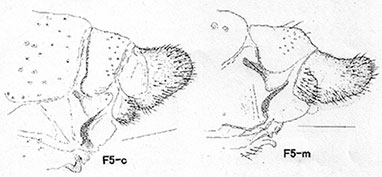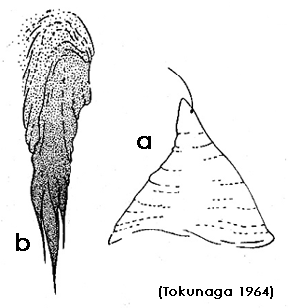Chironomus crassiforceps Kieffer 1916SynonymsChironomus esakai Tokunaga 1940 Chironomujs insolens Johannsen 1946 - synonymised with C. esakai by Hardy (1960). Yaesecundus iriobeceus Sasa & Suzuki, 2000 Chironomus daitoabeus Sasa & Suzuki 2001 Daitoyusurika daitofegea Sasa & Suzuki, 2001 Possible synonym - C. nudipes Kieffer 1911 - i.e. this could be the senior synonym for this species. The nearest neighbor is BOLD:AAJ4269 which contains C. magnivalva 10. T. crassiforceps n. sp.  Male: Fawn colour. Frons with two small white lobes. Palps of a dark brown. Antennae of 12 segments, brownish, with fawn variegation, transverse segments 3-11 twice as wide as long, the 12th twice as long as previous ten together. Mesonotum frosted white, with 3 reddish bands, short, dull, whitish; scutellum, metanotum and pleura reddish or fawn. Halteres white, extremity of club brown. Wings subhyaline, crossvein black, second longitudinal vein close to radius, cubitus more than half as long as the radius, posterior fork a little distal to the crossvein. Legs yellowish, the last two tarsal segments and the extremity of the third darker, anterior tarsus not bearded, long anterior tibia, hardly shorter than the unmarked femur, metatarsus at least longer by half than the tibia, sements 2-4 gradually and slightly shortened, the fourth not distinctly shorter than the third one, more than twice as large as the 5th, large pulvilla, shorter than empodium. Abdomen linear, of a brownish white, lateral edges black, the last two tergites and claspers a little duller than the other tergites. Large claspers, very large terminal segments, longer and larger than the basal segments, straight, slightly thinner and rounder at the edge, except the distal quarter which possesses, as well as the extremity, short hairs, erect and quite dense, the setae of the lateral part are relatively shorter than usual, shorter than the width of the segment; coxite appendages in a short point; superior appendages extend out a little past the basal segments, flat, linear, curved; inferior appendages very long, nearly reaching the extremity of the terminal segments, more than twice as large as the superior appendages, but not half as big as the terminal segments, slightly swollen before the extremity which is thinner, pubescent, dorsal surface armed, on the distal third, with long hairs, rigid and strongly curved. - L. 4.5 mm. (i.e. AR about 1.5, LR at least 1.5) Adult Wing length 2.43 (2.28-2.72) mm.; width about 0.64 (0.60-0.68); VR 0.91 (0.88-0.97). Head: AR 1.90 (1.48-1.98; Palp proportions segs. 2-5 (microns): 41 : 158 : 159 : 205 ; (P5/P4 1.07-1.50; P5/P3 1.11-1.50). Clypeal setae 23-28. Thoracic setae: acrostichal abt. 12-19; dorsolateral 11-18; prealar 5-7; supra alar 1; scutellar in approx. 2 rows ant. 5-8. post. 9-12 (total 16-20). Leg proportions and ratios (microns)
 Hypopygium: Anal point stout, gonostylus large and oval in lateral aspect, dorsal volsella long and slender; inferior volsella slightly curved, much longer than anal point and to about 2/3 of the length of the gonostylus. Female Wing length 2.36 2.08-2.77 mm; width 0.72 (0.60-0.83) mm. Head: Antennal proportions 114 ; 80 : 81 : 75 : 152; necks of intermediate segments about a third of segment length;. AR 0.44 (0.39-0.48); A5/A1 1.32 (1.28-1.42). FT prominent 46 µm long and 20 µm in diameter. Palpal proportions 38 : 38 : 133 : 148 : 213; A5/A4 1.43 (1.29-1.44); A5/A3 1.60 (1.35-1.92). Clypeus about 1.5 times the diameter of the antennal pedicel; 21.8 (20-24) clypeal setae. Thorax: Scutal vittae brown, rest brownish. Setae - Acrostichal 8-12; Dorsocentral (incl. Humeral) 16-24; Prealar 5-6; Supraalar-1; Scutellum with 7-11 small anterior setae and 8-13 in posterior row (total 19 (16-24)). Leg proportions and ratios
Abdomen largely yellow or yellowish-brown, darker at posterior. Cercus and segment X (below) very similar to that of C. magnivalva, i.e. a generally rounded outline with some indication of a bulge at the base of the ventral margin, while segment X has an enlarged, relatively rounded base.Sasa & Hasagawa (1983) describe the cercus as &ear-shaped&, 216 µm long and 376 µm high.  Variation of the cercus in specimens from Japan. (Drawing by T. Kobayashi)
Gular region slightly darkened to dark on posterior third to half, slightly wider than the width of the mentum, widest at posterior border; frontoclypeus also darkened, and slight darkening elsewhere on dorsal surface. Salivary reservoir ( Fig. d) 75.1 (58-96) µm wide and 4.7 (4.0-5.2) times wider than deep. Mentum ( Fig. e) with 4th laterals only slightly reduced (essentially type I), and c2 teeth partly separated from c1 (mostly type IB but rarely type III); width about 50-60% of the VHL. Ventromental plates ( Fig. f) separated by 43-61 µm (about 0.30-0.35 of mentum width), with about 36 (32-47) striae; VMR 0.26 (0.21-0.30). Pecten epipharyngis ( Fig. a) with about 15.8 (14-19) teeth, mostly type B when not worn. Premandible ( Fig. b) with inner tooth about 3.5-4.5 times wider than outer tooth, both reducing to a point, sometimes to a sharp point, others to a broad point as in figure. Antenna ( Fig. c) with relatively long basal segment, about a third of the VHL and 3.3 (3.1-3.7) times longer than wide; RO about 0.31 (0.25-0.37) up from the base; AR about 1.91 (1.55- 2.24), segment lengths (micron) 103 : 26 : 9 : 11.5 : 7. Distance between antennal bases (132.4 (119-159)) generally greater than that between the S4 setae (121.3 (109-147)), which are separated by 76-85% of the FA width. S5 setae about level with the nearby RO. Mandible ( Fig. f) about 218.6 (195-237) µm long, with 3rd inner teeth only slightly separated and showing some colour (type I-IIA); about 18.9 (17-20) furrows near the base; 12.5 (12-14) taeniae in Pecten mandibularis; Mdt-Mat 29.5 (25-35) µm, MTR 0.4 (0.36-0.45). Cytology: Four polytene chromosomes with the pseudothummi-cytocomplex combination BF, CD, AE, G. Nucleolus in arm F at about group 19, and a small nucleolus sometimes developed subterminally in arm G. No known inversion polymorphism. Differs from C. magnivalva by fixed inversions in arms C, E and G. craA1: 1-2c, 3-2d, 10-12, 14-13, 4-9, 15-19 as magnivalva A1 craB1: Large puff with distal dark bands (groups 7-8) near distal end of arm as magnivalva craC1: the distinctive groups 3-4 are about one quarter of the arm length from the centromere craD1: as arm D of magnivalva craE1 1-3a, 10g-c, 3f-4, 10b-5, 3e-b, 4-3f, 11-13 from cingulatus/magnivalva by Inv10g-3b craF1: 1-2a, 10d-a, 2b-9, 11-23 as magnivalva F1 craG1: Nucleolus sometimes subterminal, with BR immediately next to it, and two other BRs spread along the arm  Arm G of C.crassiforceps. Found: Type locality - Tainan, Taiwan, (Republic of China). Types were in the Natural History Museum in Budapest, and so are lost. All life stages were redescribed by Tokunaga (1939, 1964). C. nudipes was redescribed by Chaudhuri et al. (1992). This species is very closely related to Chironomus magnivalva Kieffer which occurs in northern Australia and the Pacific Islands, and to the Indian species C. nudipes KiefferC. nudipes differs from C. crassiforceps in the presence of dark spots on the abdomen, and the unusually short posterior femur (that of C. crassiforceps being longer than the tibia), as noted above, if synonymy were confirmed, C. nudipes would become the senior synonym. The information provided by Pal and Hazra (2017) is completely inadequate to confirm that the specimens that they examined were C. crassiforceps, C. nudipes or some other species entirely. It is unfortunate that they chose to publish in a journal lacking rigorous review. The major difference in the morphology of the males between C. crassiforceps and C. magnivalva is that, while the gonostyle of C. magnivalva narrows evenly to the distal end, that of C. crassiforceps appears to remain the same width for most of its length and then rounds-off (see figure above). In this latter character, C. crassiforceps seems to be similar to C. nudipes but differs in lacking the dark spots on tergites VI-VIII (although these are only mentioned in the Chaudhuri et al. redescription). C. crassiforceps and C. nudipes have both been recorded from the same area in West Bengal. |
Revised: 15 May 2024
Access: Unrestricted
Copyright © 2010-2024, Jon Martin.
